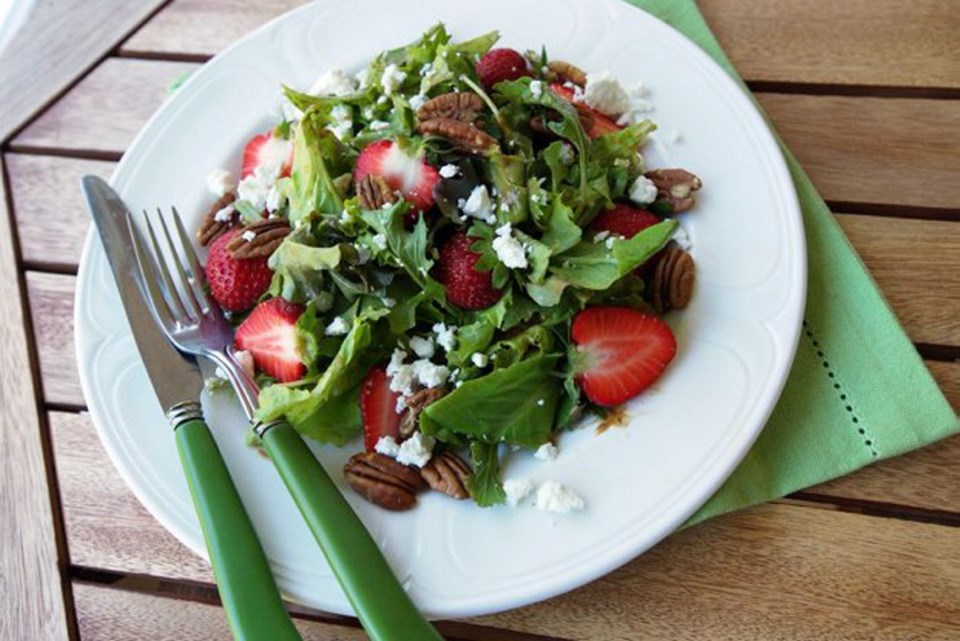 Dear Eric: I enjoyed reading your column on making vinaigrette. Olive the Senses, a business in the Hudson Building, 1701 Douglas St., has become one of my favourite places to shop and browse. I am wondering if I can use their flavoured balsamic vinegars in dressings using the same ratios as I would if I were making the dressing with regular balsamic vinegar? Also, in making vinaigrettes, can white or dark balsamic vinegar be used? Is one better than the other for dressings? I’m also very fond of their Tuscan herb olive oil and wonder about the ratios using flavoured olive oil?
Dear Eric: I enjoyed reading your column on making vinaigrette. Olive the Senses, a business in the Hudson Building, 1701 Douglas St., has become one of my favourite places to shop and browse. I am wondering if I can use their flavoured balsamic vinegars in dressings using the same ratios as I would if I were making the dressing with regular balsamic vinegar? Also, in making vinaigrettes, can white or dark balsamic vinegar be used? Is one better than the other for dressings? I’m also very fond of their Tuscan herb olive oil and wonder about the ratios using flavoured olive oil?
Gloria
Gloria’s query came in after I��answered another reader’s question on May 1 about making vinaigrette and why hers wasn’t separating.
The answer was she was not��emulsifying her vinaigrette correctly. To read that May 1 column and the one related to it��that I��wrote last week, go to timescolonist.com and search “Eric��Akis vinaigrette.”
As Gloria highlighted, when purchasing balsamic vinegar, you’ll observe it comes in many forms.
Traditional balsamic vinegar, labelled aceto balsamico tradizionale, made in Modena, in the Emilia Romagna region of Italy, is an artisan product. It’s made with grape must (juice) that is simmered, concentrated, fermented and allowed to mature a��minimum 12 years in a progression of wood barrels that get smaller and smaller as the vinegar slowly ages and evaporates.
The resulting vinegar has a beguiling intense, rich, sweet-and- sour taste and a dark colour, the latter despite the fact that the must used to make it most often comes from a white-wine grape called trebbiano.
Because of the long process, these types of balsamic vinegar are expensive, costing $100 or more for just a small bottle. With that price tag, this is a vinegar you would simply drizzle on a food, not the type you would blend into vinaigrette and thereby dilute its taste.
The types of balsamic vinegar you would use in vinaigrette are less costly, more widely available commercial-grade ones, sometimes labelled balsamic vinegar of��Modena. They are generally made by blending wine vinegar and additives, such as colouring, thickeners and caramel, to mimic the taste, texture and look of traditional balsamic vinegar.
A more refined, but still affordable type of this style of balsamic vinegar is called condimento grade, which is usually a combination of traditional and commercial-grade balsamic vinegar.
White balsamic vinegar is commercial-grade vinegar made with white-wine vinegar and grape must.
Lastly, flavoured balsamic vinegars are commercial-grade balsamic vinegars, such as those noted above, flavoured with such things as apple, coconut, berries, lemon, fig and even chili peppers.
Vinaigrette is a blend of oil and vinegar or other acidic liquid, such as lemon juice, traditionally blended in a three-to-one ratio. Depending on how tart the vinegar is, though, that ratio can go lower, such as when using sweeter-tasting balsamic vinegar, which requires less oil to cut its��acidity.
On that note, I normally go with a two-to-one ratio, but for flavoured ones might go slightly lower or higher than that, depending on how the flavouring has affected the vinegar’s sweetness or tartness. The way to determine that is to taste the vinegar before making your vinaigrette.
Both dark-hued and white balsamic vinegar are fine for vinaigrette. That said, I might opt for the latter when I don’t want the vinegar to potentially stain what I am making, such as white asparagus vinaigrette, where I want the chilled asparagus to look white after it’s dressed.
With regard to using flavoured oils in vinaigrette, types that might affect the ratio of oil to vinegar are those flavoured with��tart lemon. Another obvious thing to consider when using flavoured oils in vinaigrette is that if they are already flavoured with such things as herbs and garlic, you might not need to add any more seasoning to your vinaigrette, except salt, pepper and mustard, such as Dijon, to help emulsify it.
Baby Greens with Strawberries, Walnuts, Cheese and Fig Vinaigrette
The fig-flavoured balsamic vinegar I used in this recipe was by B.C.-based Edible Gardens. It was also flavoured with some ginger, and I bought it at Thrifty Foods. To find other locations selling it, go to ediblegardens.net. If desired, you could also try another type of flavoured balsamic vinegar in this recipe, such as the Gravenstein apple-flavoured one Gloria told me she likes to buy at Olive the Senses.
��
Preparation: 20 minutes
Cooking time: None
Makes: Four servings
��
2 Tbsp fig-flavoured balsamic vinegar
2 tsp Dijon mustard
2 tsp honey, or to taste
• salt and freshly ground black pepper
1/4 cup extra virgin olive oil
8 cups baby mix salad greens
16 to 20 small-to-medium local strawberries, each halved
1/3 cup pecan or walnut halves
100 g soft goat cheese, pulled into small nuggets
Place the vinegar, mustard, honey, salt and pepper in a salad bowl and whisk to combine. Now slowly whisk in the oil. Add the greens and toss to coat. Divide and mound salad greens on each of four plates.
Decorate the top of each salad with strawberries, nuts��and cheese, and then serve.
Eric Akis is the author of eight cookbooks. His latest is The Great Rotisserie Chicken Cookbook. His��columns appear in the Life section Wednesday and Sunday.



